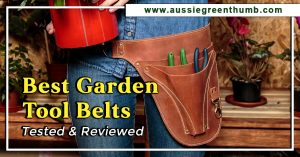Terrariums are a great, low maintenance way to manage your houseplant collection without the need for a green thumb. By creating a beautiful enclosed landscape, and making the most of the wide range of micro-foliage plants the botanical world has to offer you can create something utterly unique, and completely personal.
Terrariums are simple to build and easy to maintain, so let’s get started!
More...
What is a Terrarium?

Terrariums is a general name given to an enclosed collection of plants, curated to produce a mini living landscape. Terrariums are usually built in enclosed glass jars but work well in open glass structures.
The idea is to have a full 360 view of your tiny garden, and by using sealable jars, your plants thrive in their own humidity, and require very little ongoing care.
How do Terrariums Work?
Terrariums work by enclosing humidity and, ideally, recycling moisture, oxygen, and carbon dioxide, so that your plants are able to breathe, photosynthesise, and grow without the need for regular watering.
Round terrariums are the traditional form, with any rising humidity collecting at the highest point and falling again like rain. The soil, gravel, or grit layer at the base of your terrarium has several purposes too.
By adding a base layer of gravel or grit, you provide a sink pool for any excess moisture, which prevents the roots (usually self-restricted to the soil layer) from rotting in damp conditions.
If the plants put on a growth spurt, using nutrients and water stored in the stems, the excess water in the grit layer is then soaked into the compost.
DIY Terrarium Ideas
Building your own terrarium couldn’t be simpler, and with just a few extra basic materials, you can get started using stuff you’ve probably already got lying around.

How to Make a Terrarium
Terrariums are easy to build at home, and even easier ways to create unique growing environments, you can find plenty of gorgeous terrarium kits online (check out our reviews at the end of this article).
But if you want full creative control, follow our guide to building a simple terrarium that works for most plants:
Tools & Materials
Almost all of the terrarium ideas below use the same basic materials:
- A glass jar, fish bowl, or container
- Pea gravel, or horticultural grit
- Sand
- Sieved soil, or cactus compost
- Decorative gravel
The glass jar keeps everything visible, and those with closed lids are ideal for maintaining humidity and dropping the watering schedule right down to once a month at most.
Pea gravel or grit provides a reservoir layer, so roots self-prune, or adapt, rather than sitting in boggy compost. A layer of sand separates the soil for the gravel reservoir and will remain mostly dry unless the soil needs to soak up moisture from below.


Get Your Free Guide:
Master Growing Australian Natives eBook
A Must Have Complete Guide for Every Australian Garden
Get Your Free Guide:
Master Growing Australian Natives eBook
A Must Have Complete Guide for Every Australian Garden
Sieved soil or cactus compost are both perfect substrates for terrariums as they have low but balanced nutrients and good drainage. Decorative gravel, added after your plants, serves two purposes.
The first is as a purely decorative layer to frame the plants, and help young seedlings pop. The second is more important, as water droplets from the jar lid, or from watering can splash back onto foliage. The gravel layer stops this and helps to maintain healthy, clean leaves.
Where to Place a Terrarium
Choosing the best place for a terrarium depends entirely on the plants you choose. Forest floor plants like mini-ferns and mosses will be happy in any humid room with a little bit of shade, but some tropicals, including many succulents and cacti, will need full sun to thrive.
Once terrariums reach their ideal temperature they act like little greenhouses so don’t shift from hot to cold as rapidly as other houseplants. That means they can be placed in quite cool rooms if they get full sun, which will warm them in the afternoon so they retain heat through the night, even in winter.
Plants
Before you start any of these projects, choose your plants! Terrariums won’t restrict the growth of larger plants, so should always be set up for the final mature size of the plants you’re growing.
Choose your plants carefully, and then plan the type of terrarium you want, not the other way around!
15 Beautiful Terrarium Ideas
1. Glass demijohn terrariums
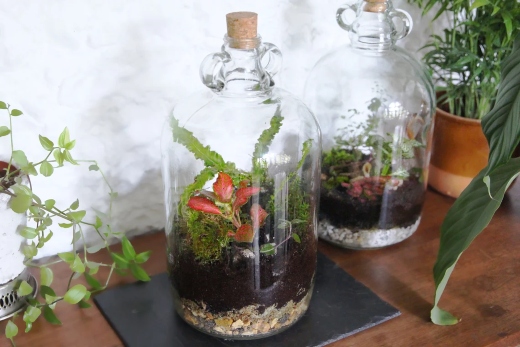
Source: WingAndWild
Demijohns make exceptional terrariums, whether you leave them open, or add cork stoppers. The rounded shoulders mean that most of the water will always fall back down as rain, and they provide plenty of space for soil layering to get exactly the right conditions for slightly taller terrarium plants.
The only downside of demijohns is that if a plant ever gets too big for the space, it is virtually impossible to remove! But, as we’ll see later on, oversized terrarium plants can be just as stunning, if not more.
See our compilation of the best terrarium plants for more options.
2. Upside-down jar terrariums
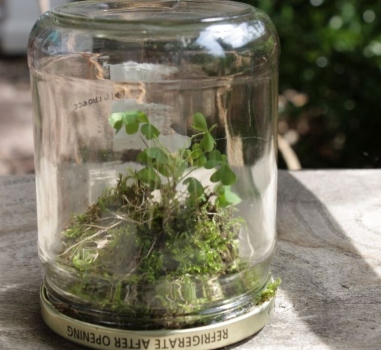
Source: Donna Morris
By far the easiest way to make a terrarium at home is with an old jar. Literally, any old jam jar will do, and won’t cost a penny. As a rule, the bigger the lid, the better, as that’s the only space you’ll have for soil.
And once it’s closed, you’ll need to be exceptionally careful when watering, and replacing the lid so the soil doesn’t all escape.
3. Decorative jar terrariums

Sweet jars or decorative pasta jars make gorgeous terrariums. They’re easy to access, simple to water, and bigger than basic kitchen jars so can usually take two or three plants for a more natural-looking mini-landscape.
If you’ve got a few to choose from, pick one with rounded shoulders. Like the demijohn-style terrariums, the shoulders will help to keep water dripping back in when it gets warm.
4. Open glass bowl terrariums
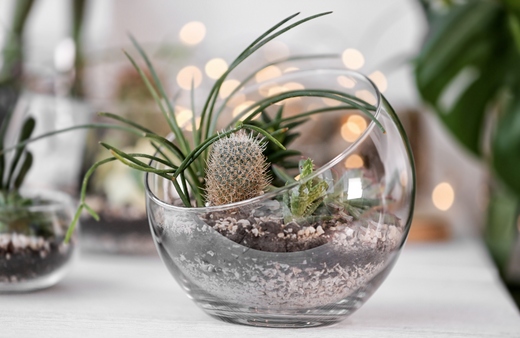
Glass bowls, mugs, or containers don’t need a lid to function as a simple terrarium. Their open structures make it easier to care for plants, but will also mean pests can get to them, and they will need watering more regularly as they have no self-enclosed climate like lidded versions.
5. Fishbowl terrariums
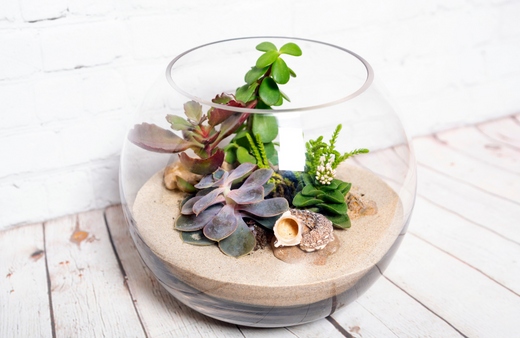
For a bigger glass bowl, pretty much any fish bowl will work, and they come in huge sizes too! If you want an open terrarium, that’s simple and gives easy access to your plants, but for a closed fishbowl terrarium, pop a glass plate over the top, or cut out a cork stopper to seal the lid.
6. Use cork to seal any glass or jar terrariums

Terrariums don’t need to be made from anything special, and as we said before, you can break a lot of rules and still have something beautiful. Any glass cup can be used as a terrarium, but you’ll need to make a lid from thick cork to seal the top.
Oxygenating pond plants make wonderfully quirky terrariums too and need nothing but rainwater to get started. Some fish tank pebbles will help to decorate it, but anything from pond lilies to marimo moss will do the job.
7. Mini greenhouse terrariums
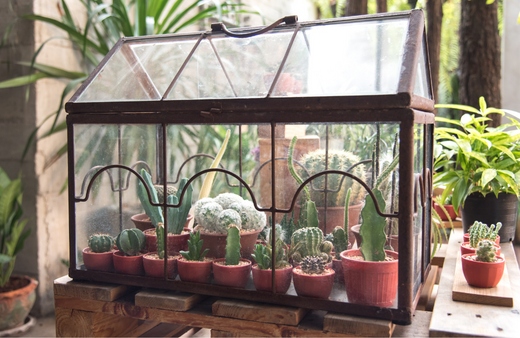
Most DIY stores and home décor shops sell these beautiful glass greenhouses as table decorations, but with a deep tray, they make a perfect terrarium environment. Simply seal the base with a tray deep enough for a few layers of grit, sand, and compost and you can grow full-sized house plants with ease.
8. Use old serving bottles as terrariums
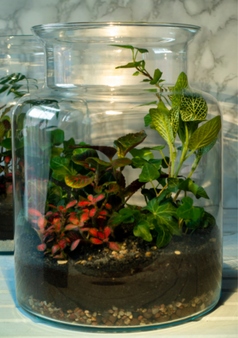
Serving bottles make beautiful alternatives to larger demijohns, and often have wide enough mouths that you can still access plants to dust them, or use chopsticks and tweezers to adjust plants when you add them later.
We’ve got a beautiful little terrarium made from an old glass coke bottle downstairs, with a single sandstone pebble and a little bit of moss. Now it’s established, it looks like a little pixie glen.
9. Ship in a bottle style terrariums
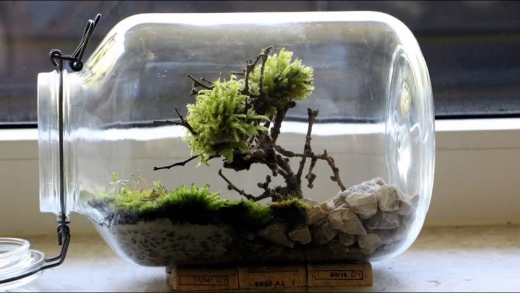
Source: Planted Well
For the craftier and more patient gardeners out there, one method that’s actually incredibly effective is to tip bottles on their side, like old-fashioned ships in bottles. Simply place your plant in the bottle, and use chopsticks to hold it upright, then, layer by layer, add grit, sand, and compost before watering with a long spouted watering can to add essential moisture.
This method is great for plants that like low humidity as it leaves one end open for ventilation, but the moisture will continue to rise and fall naturally around the curve of the bottle, meaning less watering than normal, and a slightly warmer environment for your tropical plants.
10. Tiny spice jar terrariums

Source: bob vila
One of the cutest gifts you can make this Christmas has to be these tiny spice jar terrariums. They’re perfect for mosses and trailing plants. And yes, anything other than moss will quickly outgrow its space, but they can be hung on the Christmas tree, or opened up when they’re getting cramped.
As a delicate table display, I can’t think of anything more unique for Christmas this year, and I know exactly what I’m doing after writing this now!
11. Keyring terrariums
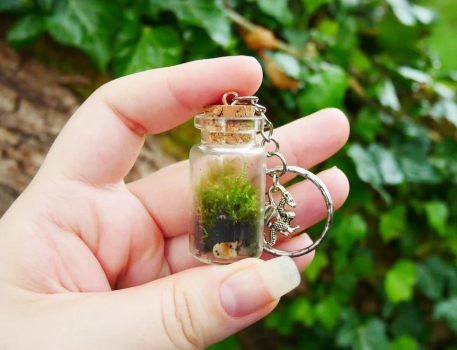
Source: GaiasGardenShopUK
If you want to keep a bit of nature with you all the time, try to make a keyring terrarium. Any tiny jar, glass, or plastic keepsake can be easily turned into a terrarium by fitting a tiny cork into the mouth of the jar.
Screw an eye hook into the cork, and attach a keyring. Then, fill the jar with a pinch of damp compost or bark and a tiny piece of moss. It doesn’t have to be anything fancy, just some moss from the garden wall will do, and you’ll have a tiny piece of nature in your pocket all the time, that won’t mind changing light conditions, and will stay perpetually humid.
12. Fish tank, or reptile tank terrariums

For really ambitious terrarium builders, try making something special with an old fish tank. They hold water and have enough space that can be super creative with your landscaping.
Use plenty of gravel and sand to create the basic form, and only over soil substrates above the water level to avoid muddy water. Use moss-like lawn to hold compost and soil in place, with mini pond plants and tropicals to fill out the landscape.
Always use treated rocks and timber as wet wood will eventually rot and ruin the terrarium. The big advantage of these designs is that fish tanks often come with built-in UV lighting, and water filters that can be used to create little streams, to manage oxygen levels.
13. Kettle terrariums
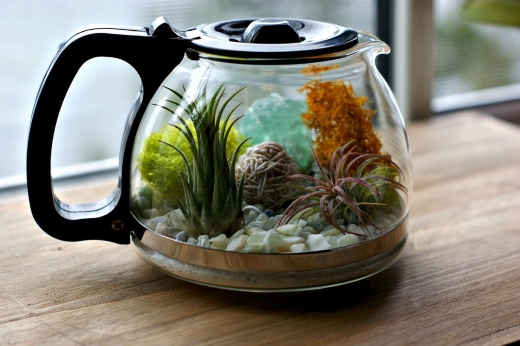
Source: A Charming Project
OK, so it doesn't have to be strictly a kettle, but I thought it was worth including this to show that you can have some real fun with your designs. Think creatively about the old kitchen equipment lying around the garage, and bring it back to life by adding plants.
If you don’t fancy planting up soil and sand layers, terrariums work just as well for air plants, which have no roots, and just need a weekly mist to keep them happy.
14. Cloche terrariums
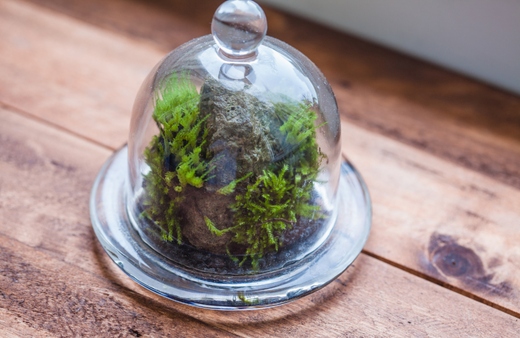
Cloche terrariums can be as ambitious or as simple as you like. Using mosses and epiphytic plants avoids the need for soil, sand, or grit as they root into the dead wood, and take moisture from the humid air around them.
Placing a cloche over the top creates a naturalistic terrarium that only ever needs watering if the narrow reservoir at the base dries out.
15. Bottled gardens – the ultimate terrarium!

Source: Bored Panda
And I couldn’t finish without mentioning David Latimer and his world record-breaking bottled garden. While it’s technically a terrarium, with plant life taking centre stage, it started out as a terrarium, featuring sand, soil, and grit, just as we do today, and has since developed into an out-of-control green oasis that hasn’t been watered since 1972!
With this bottle terrarium now standing at 62 years old, you’ve got a lot of catching up to do, but it’s worth a go, and you’ll enjoy every step of the way, regardless of what design you choose.
Keeping Your Terrarium Happy
The 62 year old glass bottle terrarium above hasn’t been watered for nearly fifty years and has been in the same spot, 6ft away from a sunny window for just under thirty years.
Once you’ve set up a terrarium, the idea is that watering isn’t ever going to be a worry again. Obviously, with open-top terrariums, you’ll need to water ever so often to top up their humidity, but for sealed terrariums, as long as they’re happy and the plants have reached maturity, their moisture consumption is simply about reproducing foliage each year and photosynthesising.
For the first couple of years, while plants are still growing, they’ll create their own water storage in stems and roots, reducing the amount of available moisture. That means you’ll need to water them once a month for the first few years (stopping watering through winter with most plants).
After that, a properly sealed terrarium shouldn’t need any extra water.
Terrarium Kits Australian Guide
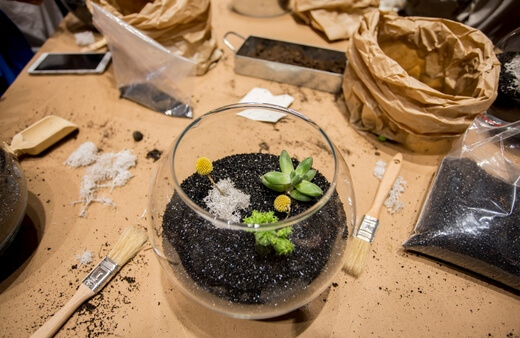
What to Look for When Buying a Terrarium Kit
There’s actually quite a lot to consider when building or buying a terrarium kit. Remember, you can be as strict or as loose as you like with the rules of what a terrarium actually is because the definition is loose in the first place.
For me though, there are some things that should always be considered with any new terrarium, so I’ll run through those before looking at the best terrarium kits you can buy online, and where to find them.
Open terrariums vs closed terrariums
Firstly, you have to decide whether you want an open or closed terrarium. Open terrariums are easy to manage, and allow you to grow young plants with warmer, cloched environments at first, before moving them into larger containers.
Closed terrariums require less care and attention, and will take longer to establish, but when they do, they take care of themselves and become magical ecosystems in their own right.
Personally, I believe that all terrariums should be planted in this way, and treated more like enclosed environments.
Lid type
If you do decide to go for a closed terrarium, it’s important to understand how each type of lid works. A loose-fitting lid, like a glass plate, or plastic film, will mean your terrarium is never truly enclosed, and moisture will escape as pressure builds on warm days.
Tight-fitting lids, like rubber or cork, are actually very slightly breathable, but completely watertight, so the pressure will stay even, and all the moisture in your terrarium will be retained. After a few years, you’ll never need to water corked terrariums.
Substrates included
And a few basic things to check when buying any terrarium kit include what exactly is included. Some terrarium kits are supplied simply as a cork and a vase, but the best terrarium kits come with all the substrate too.
For me, I prefer to pick my plants myself, but if you’re starting out with terrarium kits, try looking for those with plants included, as it’s a great way to get started with confidence in your ability as well as your plants.
Where to Buy Terrarium Kits
Considered terrarium kits are hard to come by, so I thought I’d point you in the direction of a few of our favourite shops.
Flower & Twig Nursery
For expertly prepared terrariums, try Flower & Twig, who supply everything you need in kit form as well as separate substrates, lids, and plants to customise your own growing environments.
Ladyfern Adelaide
Ladyfern Adelaide is a stunningly well-branded terrarium shop, with gorgeous tags and gift boxes to make any terrarium the perfect gift. Ladyfern also sells moss, plants, and ornaments for terrariums to provide a bit more personality.
Etsy
If you want to check out the competition, take a look at Etsy, packed with choices from a range of dedicated terrarium and terrarium suppliers who know their trade, and want to pass their skills on to gardeners everywhere.
Best Terrarium Kits for 2025
1. Rainforest Orb Terrarium Kit
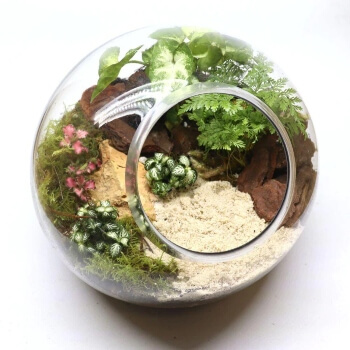
Rainforest Orb Terrarium Kit
These stunning glass orbs come with 5 terrarium plug plants, all the tools, and all the substrate you could possibly need to get started with your very own terrarium.
The open orb design from flower and Twig is great for beginners and allows you to get used to the scale and delicacy of planting terrariums.
2. Woodland Cork DIY Terrarium Kit
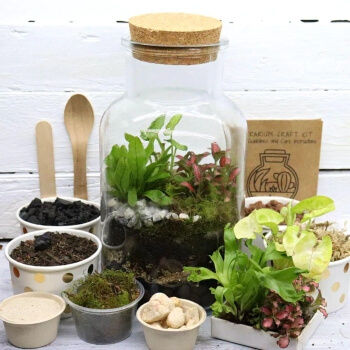
Woodland Cork DIY Terrarium Kit
Flower & Twig includes activated charcoal in this closed terrarium kit, which can help to manage humidity as well as clean the air in the terrarium. For long-term terrariums with the eventual view of zero-watering, this kit is exactly what you need.
3. Rainforest Walk DIY Terrarium Kit

Rainforest Walk DIY Terrarium Kit
The clear lid on this rainforest walk terrarium from Flower & Twig is ideal for newcomers. Rather than committing to a fitted cork stopper, the clear acrylic lid reduces watering down to once every three months, but still gives you access to your plants to care for them, dust them, and prune them as needed.
4. Tropical Closed Orb DIY Terrarium Kit
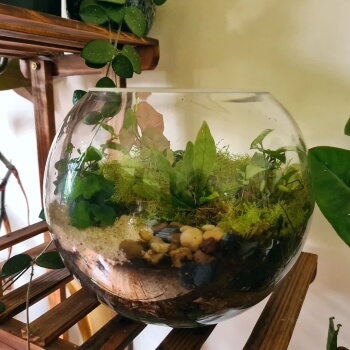
Tropical Closed Orb DIY Terrarium Kit
This large (23cm) glass orb terrarium starter kit from Flower & Twig is spot on for terrarium beginners with a bit more confidence. The larger space means you can be more ambitious with your planting, and maybe even go beyond the assorted plug plants they supply with the kit.
Its activated charcoal and generous amounts of substrate create a cleaner, more natural environment that needs watering just once every few months.Terrariums Frequently Asked Questions
What is the purpose of a terrarium?
Terrariums are self-enclosed gardens, also called vivariums and bottle gardens. They are used for keeping plants alive in self-sufficient ecosystems without additional water or nutrients.
How long do terrariums live for?
The oldest known terrarium was planted in 1960 and is still alive today. It was last watered in 1972 and was last moved around thirty years ago. In theory, there is no reason that that terrarium will not outlive me or you, and any new terrarium with proper execution can live for decades, if not centuries.
Do I need to water a terrarium?
Terrariums with loose lids should be watered once every few months to top up any escaped moisture (less than 1 tablespoon should be enough). For sealed terrariums, using cork, rubber, or a tight-fitting lid, they can survive with no additional water after the first few years – basically, as soon as the plants reach a mature size.
Do terrariums prefer sun or shade?
Terrariums can thrive in both sun and shade, but bright indirect light is best advised to prevent overeating the plants inside. Some plants, particularly arid tropical plants, will be happy in full, direct light, but the vast majority will prefer a bright spot, out of the direct light of a window.
What’s the difference between teraniums and terrariums?
There’s no specific difference between terrariums and teraniums, but for me, the difference comes in the implications of their names:
- Terrariums (from terra, or ‘earth’) are a way to create enclosed, artificial capsules of living beings. They celebrate the earth, and the flora you can grow by providing ideal microclimates, usually for tropical plants.
- Teraniums (from terrain, or ‘ground’) are, by definition, more specifically about producing a natural landscape, where the connections between plants are apparent. That can mean creating tiny dioramas or attempting to mimic natural plant groupings.
So, no, there isn’t a huge difference in the practical applications of either title for these DIY growing habitats, but what you call it will probably affect what you grow, and how to associate it with your display.
Wrapping Up Our Terrarium Guide
Terrariums are a wonderful way to make the most of small spaces. By growing miniature plants, and slow-growing varieties, you can manage a tiny garden without the need for tons of shelves and window sills. They make the ideal gift for anyone living in the city too, providing extra greenery, and spiritual garden space.
Whether you want to make it your mission to set everything up from scratch with the inspiration in this article or hunt the perfect kit to get you started, there’s no time like the present to start terrarium gardening.
Published on December 8, 2022 by Gary Clarke
Last Updated on December 27, 2024



